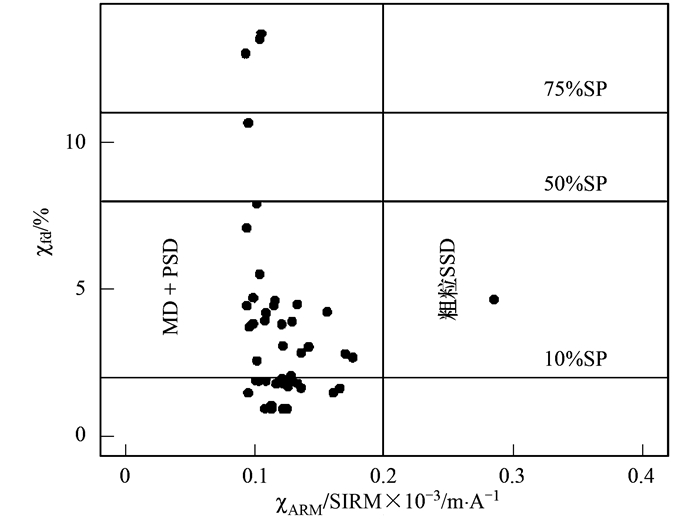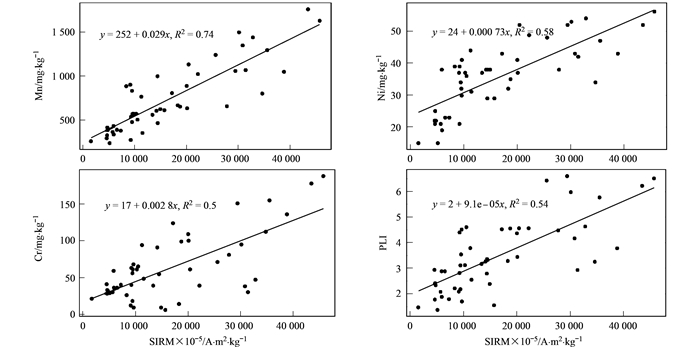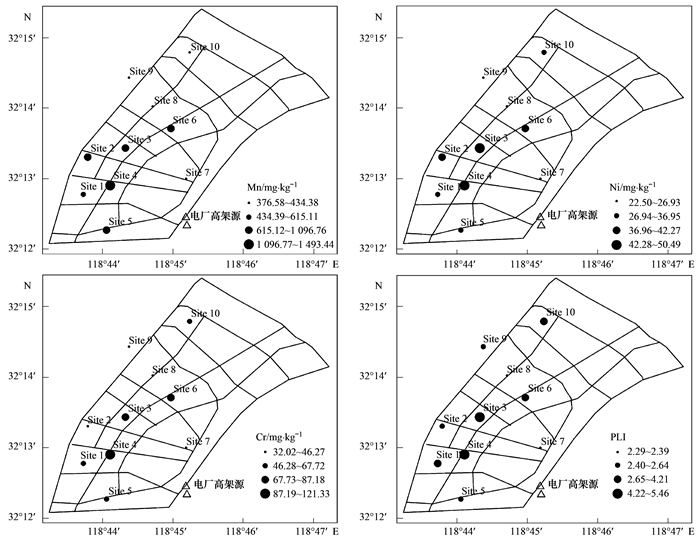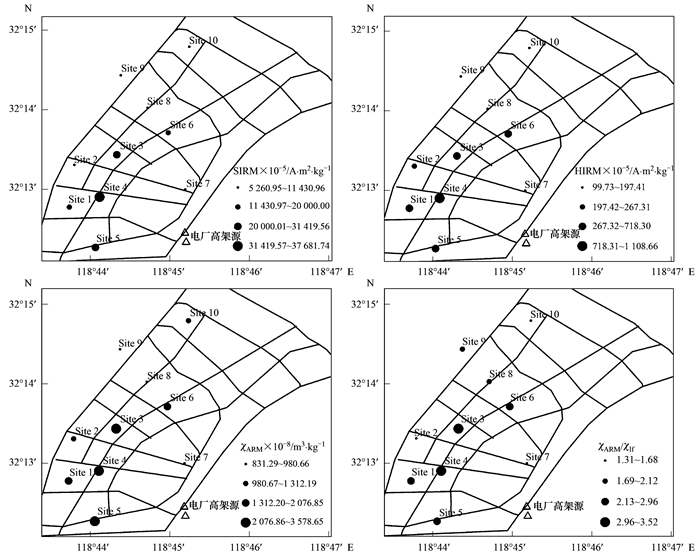2. 南京大学环境学院, 污染控制与资源化研究国家重点实验室, 南京 210023;
3. 南京信息工程大学大气物理学院, 南京 210044
2. State Key Laboratory of Pollution Control and Resources Reuse, School of the Environment, Nanjing University, Nanjing 210023, China;
3. School of Atmospheric Physics, Nanjing University of Information Science & Technology, Nanjing 210044, China
来自污染源的颗粒物沉积在城市不透水地面形成地表灰尘.地表灰尘是重金属污染物的重要载体, 可通过再悬浮-呼吸、口手摄入和皮肤接触进入人体并危害健康[1~3].重金属的毒性与含量和化学形态有关, 含量和化学形态一般通过传统的实验室化学分析方法来确定.由于磁性颗粒是重金属的强吸附剂和载体, 磁性参数可以作为环境介质中重金属污染物含量的替代指标, 环境磁学作为重金属污染研究的一种间接手段, 与传统方法相比具有快速、经济、无损和信息量大等特点[4], 已被用于多种环境介质的重金属污染研究[5~14].
人为污染物所含的磁性颗粒与原生及次生磁性矿物在含量、类型及粒径组成上均存在差异[15], 人为污染物进入地表灰尘后, 改变了其中磁性物质的存在状况, 使其磁性特征具有人类活动的标记.对城市地表灰尘的研究发现, 某些磁学参数与重金属含量具有显著的相关性以及一致的空间变化特征, 且磁性矿物和重金属具有相同的来源, 表明磁学参数可以指示城市地表灰尘重金属污染状况[16~20].然而, 这些研究是以街道灰尘作为研究对象, 不是针对儿童活动场所的地表灰尘.与成年人相比, 儿童容易摄入更多的地表灰尘, 且对重金属具有更高的吸收率和敏感性[21].街道并非城市儿童户外活动的主要场所, 与之相比, 幼儿园、小学或公园等场所的户外活动设施及其附近的不透水面对城市儿童地表灰尘暴露更为重要.然而, 针对儿童户外活动场所开展的地表灰尘研究较少.我国对西安[22, 23]、武汉[24]和香港[25]的户外儿童游乐场开展的研究表明:地表灰尘样品受到不同程度的重金属污染; 结合环境磁学和Pb同位素分析表明工业活动是城市幼儿园和小学校园地表灰尘的主要来源[24].工业区是城市重金属污染较为严重的区域[18, 26], 户外游乐场地表灰尘是城市儿童重金属暴露的重要介质, 因此, 有必要针对工业区户外儿童游乐场所的地表灰尘重金属污染开展深入研究.
本文以南京市一个工业区为例, 选择10个户外儿童游乐场进行地表灰尘采集, 结合磁性测量和重金属测定, 分析磁学参数和重金属的相关关系和来源, 进而探讨磁学参数对工业区户外儿童游乐场地表灰尘重金属污染的指示性意义, 以期为户外儿童游乐场地表灰尘重金属污染监测提供新的科学依据, 并为降低工业区儿童的重金属暴露提供支撑.
1 材料与方法 1.1 研究区概况研究区为南京市北部的大厂地区(图 1), 面积约30 km2, 常住人口19万, 是典型的居住和工业用地混合区.该区是南京的主要化学工业基地, 有电厂、钢铁、石化等企业, 企业高架源(图 1)排放的污染物通过沉降作用进入地表灰尘, 是潜在的重金属污染源.该地区主导风向为东南风, 可能给位于污染源下风向的人口, 特别是儿童带来健康风险.

|
S1钢铁厂高架源、S2和S3电厂高架源、S4~S6石化企业高架源; Site1~10为采样的游乐场编号 图 1 研究区、采样的游乐场以及高架源位置 Fig. 1 Study area, sampled playgrounds, and stacks of industrial plants |
选择研究区内幼儿园、小学以及居民小区内面积相近的10个户外儿童游乐场(图 1), 于2015年4月进行地表灰尘样品采集, 采样前累积晴天数为5 d.每个户外儿童游乐场均匀布设4~5个样点, 用塑料铲和毛刷清扫儿童活动器材和附近地面的灰尘, 每个样点收集样品质量约40 g; 其中2个游乐场因地表灰尘较少, 如果布设5个样点, 则样品质量达不到40 g, 因此仅布设4个样点; 共收集到样品48个, 将样品装入塑料袋密封.样品在实验室自然风干, 剔除杂质, 过1 mm尼龙筛, 供磁学测量.用四分法取部分样品, 过63 μm的尼龙筛, 供化学分析.
1.3 化学分析重金属总量分析用电热板湿法消解[18], 采用硝酸-氢氟酸-高氯酸高温溶解0.5 g样品.研究表明酸可提取态重金属具有较高的环境风险[27], 为了研究酸可提取态重金属与环境磁学参数的关系, 利用欧共体修正BCR的第一步提取酸可提取态重金属[27].样品重金属总量和酸可提取态的测定采用电感耦合等离子体质谱(ICP-MS, Perkin Elmer SCIEX, Elan 9000)和电感耦合等离子体原子发射光谱仪(ICP-AES, Perkin Elmer SCIEX, Optima 5300).为保证分析结果的准确性, 测定了国家标准土壤物质(GBW07405)中重金属元素的总量.以上化学分析工作主要在南京大学现代分析中心完成.
1.4 磁学测量称取约4 g样品装入磁学专用样品盒并压实待测.在室温下采用Bartington MS2磁化率仪测定低频(频率为470 Hz)质量磁化率(χlf)和高频(频率为4 700 Hz)质量磁化率(χhf), 并计算频率磁化率χfd=(χlf-χhf)/χlf×100%.用Dtech交变退磁仪和JR6旋转磁力仪测量非磁滞剩磁(ARM), 使用最大交流场为100 mT, 外加直流场为0.04 mT, 计算出非磁滞磁化率(χARM).使用Molspin脉冲磁化仪和旋转磁力仪测量样品的等温剩磁(IRM)和饱和等温剩磁(SIRM), SIRM的外加磁场强度为1 000 mT, 并测得反向磁场中的等温剩磁IRM9(包括-100 mT和-300 mT).计算S-ratio=IRM-300 mT/SIRM, 硬剩磁HIRM=[(SIRM+IRM-300 mT)/2]/mass (mass代表质量), 以及比值参数χARM/SIRM.以上磁学参数测定在华东师范大学河口海岸学国家重点实验室完成.
1.5 污染评价利用Tomlinson污染负荷指数(tomlinson pollution load index, PLI)评估重金属污染程度[28]:

|
(1) |
式中, PLI为某地表灰尘样品多种重金属元素的污染负荷指数; n为参与评价的重金属元素个数; CFi为该样品中元素i的污染系数, 等于该样品中元素i的实测含量与所有样品中元素i的最低含量的比值.
利用富集系数(enrichment factor, EF)评估地表灰尘样品中重金属的富集程度[29]:

|
(2) |
式中, EF为某地表灰尘样品中重金属x的富集系数; (Cx/Cref)sample为该灰尘样品中重金属x含量与参考元素(Al)含量的比值; (Bx/Bref)background为背景样品中重金属x含量与参考元素(Al)含量的比值.背景样品的元素含量来自文献[30].
2 结果与分析 2.1 重金属含量与污染评价地表灰尘样品中重金属总量从大到小为:Fe>Al>Mn>Zn>Cu>Pb>Cr>Ni>Co>Cd(表 1).与南京市街道灰尘研究[18, 27]相比, 本研究中Mn的总量较高, Co和Cu的总量较低.重金属元素的EF均大于10(表 1), 根据EF的分类标准[18], 这些元素均存在不同程度的富集.其中, Cd、Zn、Cu和Pb为极高富集, 说明受到的人为污染极其严重; Mn和Ni为高富集, 受到的人为污染较为严重.其他元素为显著富集, 其中Fe和Co的EF略大于10, 说明受到的人为污染较小、存在一部分的自然源[31]. PLI指数取值范围为1.37~6.60, 平均值为3.49(表 2), 表明样品的重金属污染程度差异较大, 平均受到中度到高度的重金属污染[18].
|
|
表 1 样品重金属含量、富集系数(EF)和风险评估编码(RAC)统计量1)(n=48) Table 1 Summary of heavy metal concentrations, enrichment factor (EF) and risk assessment code (RAC) of dust samples |
|
|
表 2 样品磁学参数和PLI的统计量(n=48) Table 2 Summary of magnetic parameter values and pollution load index (PLI) of dust samples |
重金属酸可提取态含量如表 1所示. Zn和Mn的酸可提取态在总量中所占的比例最高, 分别为56.48%和34.38%, 表明在酸性条件下迁移性最强[32, 33]. Fe的酸可提取态占比最低(1.24%), 迁移性最弱[32, 33].其他元素酸可提取态占比低于10.00%, 迁移性较低.风险评估编码法(risk assessment code, RAC)基于酸可提取态在总量中所占的比例来评估环境风险的高低[34, 35], 结果表明:Zn具有极高的环境风险, Mn为高风险, Cd和Co为中等风险, 其他元素为低风险(表 1).以上结果与其他研究相似[27, 32].
2.2 磁学属性磁化率是指物质在外加磁场下被磁化的难易程度, 其大小主要反映了样品中亚铁磁性矿物的含量[15]. SIRM也可以反映样品磁性强弱, 但与磁化率不同的是, SIRM不受顺磁性和抗磁性物质的影响, 主要由亚铁磁性矿物和不完整反铁磁性矿物所贡献[20].由表 2可知, 大厂儿童游乐场地表灰尘样品χlf和SIRM的平均值分别为939.31×10-8m3·kg-1和16 618.74×10-5A·m2·kg-1, 高于重金属污染较轻的商业区和文教区[18], 表明工业区儿童游乐场地表灰尘磁性矿物含量较高. S-ratio是指示样品中亚铁磁性矿物和不完整的反铁磁性矿物相对含量的磁学参数, 并随着不完整的反铁磁性矿物贡献的增加而下降[19].由表 2可知, 样品S-ratio值较高且比较稳定, 平均值为0.97, 标准差为0.01, 表明了亚铁磁矿物占主导.
由于χARM对稳定单畴(SSD)颗粒的敏感性, 比值参数χARM/χlf可指示亚铁磁性矿物颗粒的大小, 较高的比值反映了较多的SSD颗粒, 而较低的比值则显示了较多的多畴(MD)或超顺磁(SP)颗粒[36]. χARM/SIRM也指示磁性颗粒的粒度变化, 但由于不受SP颗粒的影响, 较低的比值则反映了较多的MD颗粒[36].本研究中大多数样品χARM/χlf < 10, 所有样品χARM/SIRM < 0.50×10-3 m·A-1, 指示了亚铁磁性矿物以假单畴(PSD)-较粗的多畴(MD)颗粒为主. χfd是当外加磁场频率增大时磁化率增减的百分率, 也可指示磁性矿物的粒径大小, 区分SP颗粒和单畴(SD)颗粒[37]. Dearing图通过χfd和χARM/SIRM来判断磁性矿物颗粒大小[15], 其同样表明大多数样品的磁性矿物以假单畴-多畴颗粒为主, 但少数样品χfd达5%以上, 表明存在一定量的SP颗粒(图 2).

|
图 2 样品的Dearing图(n=48) Fig. 2 Dearing plot of dust samples |
为明确重金属及磁性矿物的来源及两者之间的内在联系, 对样品中重金属含量参数和磁学参数进行相关分析.结果表明磁学参数(χlf、SIRM、HIRM、χARM以及χARM/SIRM)与部分元素的总量和酸可提取态占比均具有显著的相关性, 且与总量的相关性较强(表 3).由于磁铁矿主要位于残渣态[38], 磁性矿物含量主要与残渣态存在强的正相关, 与酸可提取态相关性不强[39].因此, 下文主要关注重金属总量与磁学参数的关系.
|
|
表 3 样品磁学参数与重金属含量参数的Pearson相关系数(r)1) (n=48) Table 3 Pearson's correlation coefficients (r) between magnetic properties and heavy metal concentrations of dust samples |
与反映磁性矿物粒径大小的参数(χARM/SIRM)相比, 反映磁性矿物含量的参数(χARM和SIRM)与重金属元素总量的相关性更强.即, 磁性矿物含量对重金属污染的响应比磁性颗粒大小敏感[18, 20]. χARM和SIRM与Ni、Mn和Cr总量以及PLI呈强正相关(r>0.69)(表 3), 表明其指示重金属污染的高可行性.用SIRM预测Ni、Mn和Cr总量以及PLI的线性回归方程如图 3所示. χARM/SIRM与重金属含量弱相关, χARM/SIRM越大、重金属含量以及PLI越小(表 3).即, 亚铁磁和反铁磁性颗粒的磁晶粒度越小, 重金属含量越低[6, 20].

|
图 3 样品SIRM与Mn、Ni和Cr总量以及PLI的线性回归线(n=48) Fig. 3 Linear correlation analysis between SIRM and Mn, Ni, Cr, and PLI for dust samples |
将磁学参数以及重金属总量数据标准化后进行主成分分析以初步判断其来源, 结果如表 4所示.得到特征值大于1的主成分5个, 累计方差贡献率为88%.其中, 第一主成分的方差贡献率为50%, 该主成分中磁学参数(χARM、SIRM、HIRM、χARM/SIRM)以及多种元素总量和PLI的载荷大于0.60.重金属元素载荷从大到小排序是:Ni>Mn>Cd>Cu>Pb>Cr>Co.这些元素的主要人为来源均是工业(电厂或工业锅炉)燃煤[40], 这表明第一主成分中重金属的来源主要与工业活动有关.根据相关分析的结果(表 4), 除了χARM/SIRM和Pb的相关性不显著外, 第一主成分中的磁学参数与重金属元素均显著相关, 这表明磁性颗粒和这些元素具有相同的人为来源, 且主要与工业活动有关. Ng等[25]对香港儿童活动场所地表灰尘的研究也发现Pb与多个磁学参数(包括χARM/SIRM)均无显著相关, 认为这和低铅汽油的使用减少了交通源向地表灰尘的Pb输入有关.自1991年我国使用低铅汽油以来, Pb的主要来源从交通变为工业锅炉燃煤[40], 因此, Pb与其他主要来自工业燃煤的元素同处第一主成分是合理的.第二主成分的贡献率为16%, 该成分主要在Al和Fe上有较高的载荷, 这两种元素为地壳元素[41], 表明第二主成分主要受制于母质和自然过程.
|
|
表 4 样品重金属总量和磁学参数的主成分分析结果1) Table 4 Principal component analysis for the heavy metal total concentrations and magnetic parameters |
3.3 磁学参数与重金属污染源的空间关系
以磁学参数作为替代指标研究工业点源造成的污染, 发现工业点源附近、主导风向下风向的区域环境介质磁化率增强、污染物含量较高[42~44].本研究也发现在距电厂较近且在其主导风向(东南风)下风向的游乐场Mn、Ni、Cr和Cd总量以及PLI指标取值较大(图 4), 部分磁学参数(SIRM、χARM、χfd和χARM/χlf)也具有相似的空间特征(图 5).参考重金属含量和磁学参数的空间分布, 初步将游乐场分成两类:A类距电厂较近且在其主导风向下风向, 包括编号为Site3、Site4和Site6的游乐场; 其他距电厂较远或不在其下风向的游乐场为B类.虽然Site7距离电厂较近, 但是不在其下风向, PLI和磁学参数值均较低, 因此, 将其归于B类.方差分析表明两类儿童游乐场的磁学参数和重金属总量均存在显著差异(表 5). A类儿童游乐场的Mn、Ni、Cr和Cd总量以及PLI显著高于B类(P < 0.01).由于Mn、Ni、Cr和Cd主要来自电厂燃煤[40], 推断电厂燃煤是该工业区儿童游乐场地表灰尘重金属的重要来源. A类的χlf和SIRM显著较大(P < 0.05)(表 5), 表明位于工业源下风向且距离较近的地表灰尘磁性矿物含量较高[15, 20]. A类的χfd和χARM/χlf也显著较大(P < 0.05), 表明SP占比较大[15, 36].燃烧产生的磁性颗粒主要为细颗粒, 以SP颗粒为主并伴有SSD颗粒[15], 因此, 推断A类儿童游乐场地表灰尘中的磁性颗粒更多地来源于电厂燃煤.

|
图 4 Mn、Ni、Cr总量以及PLI指数的空间分布 Fig. 4 Spatial distribution of total concentrations for Mn, Ni, Cr and PLI |

|
图 5 SIRM、HIRM、χARM和χARM/χlf的空间分布 Fig. 5 Spatial distribution of SIRM, HIRM, χARM and χARM/χlf |
|
|
表 5 两类儿童游乐场的磁学指标、重金属含量以及PLI比较1) Table 5 Comparison of magnetic parameters, heavy metal concentrations and PLI in two types of sampling sites |
4 结论
(1) 研究区内的户外儿童游乐场地表灰尘重金属污染问题不容忽视, 污染程度为中度到高度; 重金属元素存在不同程度的富集, 特别是Cd、Zn、Cu和Pb为极高富集.
(2) 研究区内的户外儿童游乐场地表灰尘磁性矿物含量相对较高, 以亚铁磁性矿物为主, 主要以假单畴-多畴颗粒存在, 少数样品有一定量的超顺磁颗粒.
(3) 磁学参数可以有效指示工业区户外儿童游乐场地表灰尘的重金属污染状况, 表现在以下3个方面. ①部分磁学参数与重金属元素总量和酸可提取态占比均显著相关, 且与总量的相关性较强; 其中, Mn、Ni、Cr总量以及PLI与χARM和SIRM的相关性较高. ②磁学参数(SIRM、χARM、χfd和χARM/χlf)与Mn、Ni、Cr和Cd总量以及PLI具有一致的空间变化特征, 表现为距电厂较近且在其下风向的游乐场重金属总量、PLI以及磁学参数值均较高. ③重金属和磁性矿物均主要来自工业活动, 特别是电厂燃煤.
| [1] | Cao S Z, Duan X L, Zhao X G, et al. Health risks of children's cumulative and aggregative exposure to metals and metalloids in a typical urban environment in China[J]. Chemosphere, 2016, 147: 404-411. DOI:10.1016/j.chemosphere.2015.12.134 |
| [2] | Mohmand J, Eqani S A M A S, Fasola M, et al. Human exposure to toxic metals via contaminated dust:bio-accumulation trends and their potential risk estimation[J]. Chemosphere, 2015, 132: 142-151. DOI:10.1016/j.chemosphere.2015.03.004 |
| [3] | Wang J H, Li S W, Cui X Y, et al. Bioaccessibility, sources and health risk assessment of trace metals in urban park dust in Nanjing, southeast China[J]. Ecotoxicology and Environmental Safety, 2016, 128: 161-170. DOI:10.1016/j.ecoenv.2016.02.020 |
| [4] | Liu Q S, Roberts A P, Larrasoaña J C, et al. Environmental magnetism:principles and applications[J]. Reviews of Geophysics, 2012, 50(4): RG4002. |
| [5] | Botsou F, Sungur A, Kelepertzis E, et al. Insights into the chemical partitioning of trace metals in roadside and off-road agricultural soils along two major highways in Attica's region, Greece[J]. Ecotoxicology and Environmental Safety, 2016, 132: 101-110. DOI:10.1016/j.ecoenv.2016.05.032 |
| [6] | Bourliva A, Papadopoulou L, Aidona E. Study of road dust magnetic phases as the main carrier of potentially harmful trace elements[J]. Science of the Total Environment, 2016, 553: 380-391. DOI:10.1016/j.scitotenv.2016.02.149 |
| [7] | Bourliva A, Papadopoulou L, Aidona E, et al. Characterization and geochemistry of technogenic magnetic particles (TMPs) in contaminated industrial soils:assessing health risk via ingestion[J]. Geoderma, 2017, 295: 86-97. DOI:10.1016/j.geoderma.2017.02.001 |
| [8] | Jordanova D, Jordanova N, Petrov P. Magnetic susceptibility of road deposited sediments at a national scale-Relation to population size and urban pollution[J]. Environmental Pollution, 2014, 189: 239-251. DOI:10.1016/j.envpol.2014.02.030 |
| [9] |
刘飞, 褚慧敏, 郑祥民. 上海市公园绿地树叶对大气重金属污染的磁学响应[J]. 环境科学, 2015, 36(12): 4374-4380. Liu F, Chu H M, Zheng X M. Magnetic Response of dust-loaded leaves in parks of shanghai to atmospheric heavy metal pollution[J]. Environmental Science, 2015, 36(12): 4374-4380. |
| [10] | Liu D X, Ma J H, Sun Y L, et al. Spatial distribution of soil magnetic susceptibility and correlation with heavy metal pollution in Kaifeng City, China[J]. CATENA, 2016, 139: 53-60. DOI:10.1016/j.catena.2015.11.004 |
| [11] | Muñoz D, Aguilar B, Fuentealba R, et al. Environmental studies in two communes of Santiago de Chile by the analysis of magnetic properties of particulate matter deposited on leaves of roadside trees[J]. Atmospheric Environment, 2017, 152: 617-627. DOI:10.1016/j.atmosenv.2016.12.047 |
| [12] | Szuszkiewicz M, Łukasik A, Magiera T, et al. Combination of geo-pedo-and technogenic magnetic and geochemical signals in soil profiles-diversification and its interpretation:a new approach[J]. Environmental Pollution, 2016, 214: 464-477. DOI:10.1016/j.envpol.2016.04.044 |
| [13] | Xia D S, Wang B, Yu Y, et al. Combination of magnetic parameters and heavy metals to discriminate soil-contamination sources in Yinchuan-a typical oasis city of northwestern China[J]. Science of the Total Environment, 2014, 485-486: 83-92. DOI:10.1016/j.scitotenv.2014.03.070 |
| [14] |
许淑婧, 夏敦胜, 春喜, 等. 呼和浩特市大气降尘磁学特征及其环境意义[J]. 中国环境科学, 2014, 34(4): 1004-1011. Xu S J, Xia D S, Chun X, et al. Magnetic properties of dustfall in Hohhot and their environmental implications[J]. China Environmental Science, 2014, 34(4): 1004-1011. |
| [15] | Dearing J. Environmental magnetic susceptibility:using the bartington MS2 system[M]. Kenilworth: Chi Publishing, 1999. |
| [16] | Crosby C J, Fullen M A, Booth C A, et al. A dynamic approach to urban road deposited sediment pollution monitoring (Marylebone Road, London, UK)[J]. Journal of Applied Geophysics, 2014, 105: 10-20. DOI:10.1016/j.jappgeo.2014.03.006 |
| [17] |
房妮, 张俊辉, 王瑾, 等. 西安城市不同功能区街道灰尘磁学特征及环境污染分析[J]. 环境科学, 2017, 38(3): 924-935. Fang N, Zhang J H, Wang J, et al. Magnetic characteristics and environmental pollution analysis of street dust in different functional zones of Xi'an city[J]. Environmental Science, 2017, 38(3): 924-935. |
| [18] | Li H M, Qian X, Wei H T, et al. Magnetic properties as proxies for the evaluation of heavy metal contamination in urban street dusts of Nanjing, southeast China[J]. Geophysical Journal International, 2014, 199(3): 1354-1366. DOI:10.1093/gji/ggu253 |
| [19] |
聂燕, 王新, 王博, 等. 西北典型工矿型城市街道尘埃重金属污染的环境磁学响应[J]. 环境科学, 2015, 36(9): 3438-3446. Nie Y, Wang X, Wang B, et al. Magnetic responses of heavy metals in street dust of typical mine-based city, northwest China[J]. Environmental Science, 2015, 36(9): 3438-3446. |
| [20] | Wang G, Oldfield F, Xia D S, et al. Magnetic properties and correlation with heavy metals in urban street dust:a case study from the city of Lanzhou, China[J]. Atmospheric Environment, 2012, 46: 289-298. |
| [21] | Järup L. Hazards of heavy metal contamination[J]. British Medical Bulletin, 2003, 68(1): 167-182. DOI:10.1093/bmb/ldg032 |
| [22] | Chen H, Lu X W, Li L Y. Spatial distribution and risk assessment of metals in dust based on samples from nursery and primary schools of Xi'an, China[J]. Atmospheric Environment, 2014, 88: 172-182. DOI:10.1016/j.atmosenv.2014.01.054 |
| [23] | Lu X W, Zhang X L, Li L Y, et al. Assessment of metals pollution and health risk in dust from nursery schools in Xi'an, China[J]. Environmental Research, 2014, 128: 27-34. DOI:10.1016/j.envres.2013.11.007 |
| [24] | Zhu Z M, Sun G Y, Bi X Y, et al. Identification of trace metal pollution in urban dust from kindergartens using magnetic, geochemical and lead isotopic analyses[J]. Atmospheric Environment, 2013, 77: 9-15. DOI:10.1016/j.atmosenv.2013.04.053 |
| [25] | Ng S L, Chan L S, Lam K C, et al. Heavy metal contents and magnetic properties of playground dust in Hong Kong[J]. Environmental Monitoring and Assessment, 2003, 89(3): 221-232. DOI:10.1023/A:1026103318778 |
| [26] | Peña-Fernández A, Lobo-Bedmar M C, González-Muñoz M J. Annual and seasonal variability of metals and metalloids in urban and industrial soils in Alcalá de Henares (Spain)[J]. Environmental Research, 2015, 136: 40-46. DOI:10.1016/j.envres.2014.09.037 |
| [27] | Li H M, Qian X, Hu W, et al. Chemical speciation and human health risk of trace metals in urban street dusts from a metropolitan city, Nanjing, SE China[J]. Science of the Total Environment, 2013, 456-457: 212-221. DOI:10.1016/j.scitotenv.2013.03.094 |
| [28] | Angulo E. The Tomlinson pollution load index applied to heavy metal 'Mussel-Watch' data:a useful index to assess coastal pollution[J]. Science of the Total Environment, 1996, 187(1): 19-56. DOI:10.1016/0048-9697(96)05128-5 |
| [29] | Chabukdhara M, Nema A K. Assessment of heavy metal contamination in Hindon River sediments:a chemometric and geochemical approach[J]. Chemosphere, 2012, 87(8): 945-953. DOI:10.1016/j.chemosphere.2012.01.055 |
| [30] | 中国环境监测总站. 中国土壤元素背景值[M]. 北京: 中国环境科学出版社, 1990. |
| [31] |
方宏达, 陈锦芳, 段金明, 等. 厦门市郊区PM2.5和PM10中重金属的形态特征及生物可利用性研究[J]. 生态环境学报, 2015, 24(11): 1872-1877. Fang H D, Chen J F, Duan J M, et al. Speciation characteristics and bioavailability of heavy metal elements in PM2.5 and PM10 in the suburbs of Xiamen[J]. Ecology and Environmental Sciences, 2015, 24(11): 1872-1877. |
| [32] | Keshavarzi B, Tazarvi Z, Rajabzadeh M A, et al. Chemical speciation, human health risk assessment and pollution level of selected heavy metals in urban street dust of Shiraz, Iran[J]. Atmospheric Environment, 2015, 119: 1-10. DOI:10.1016/j.atmosenv.2015.08.001 |
| [33] | YƖldƖrƖm G, TokalƖo Dǧlu Ş. Heavy metal speciation in various grain sizes of industrially contaminated street dust using multivariate statistical analysis[J]. Ecotoxicology and Environmental Safety, 2016, 124: 369-376. DOI:10.1016/j.ecoenv.2015.11.006 |
| [34] | Perin G, Craboledda L, Lucchese M, et al. Heavy metal speciation in the sediments of northern Adriatic Sea:a new approach for environmental toxicity determination[A].In:Lakkas TD (ed.).Heavy Metals in the Environment, Vol 2. Edinburgh:CEP Consultants, 1985. 454-456. |
| [35] | Yang J, Chen L, Liu L Z, et al. Comprehensive risk assessment of heavy metals in lake sediment from public parks in Shanghai[J]. Ecotoxicology and Environmental Safety, 2014, 102: 129-135. DOI:10.1016/j.ecoenv.2014.01.010 |
| [36] | 张卫国, 俞立中. 长江口潮滩沉积物的磁学性质及其与粒度的关系[J]. 中国科学(D辑), 2002, 32(9): 783-792. |
| [37] |
薛勇, 周倩, 李远, 等. 曹妃甸围填海土壤重金属积累的磁化率指示研究[J]. 环境科学, 2016, 37(4): 1306-1312. Xue Y, Zhou Q, Li Y, et al. Heavy metals accumulation in the Caofeidian reclamation soils:indicated by soil magnetic susceptibility[J]. Environmental Science, 2016, 37(4): 1306-1312. |
| [38] | Sipos P, Márton M, May Z, et al. Geochemical, mineralogical and magnetic characteristics of vertical dust deposition in urban environment[J]. Environmental Earth Sciences, 2014, 72(3): 905-914. DOI:10.1007/s12665-013-3013-8 |
| [39] | Botsou F, Karageorgis AP, Dassenakis E, et al. Assessment of heavy metal contamination and mineral magnetic characterization of the Asopos River sediments (Central Greece)[J]. Marine Pollution Bulletin, 2011, 62(3): 547-563. DOI:10.1016/j.marpolbul.2010.11.029 |
| [40] | Tian H Z, Zhu C Y, Gao J J, et al. Quantitative assessment of atmospheric emissions of toxic heavy metals from anthropogenic sources in China:historical trend, spatial distribution, uncertainties, and control policies[J]. Atmospheric Chemistry and Physics, 2015, 15(17): 12107-12166. |
| [41] | Wang J, Hu Z M, Chen Y Y, et al. Contamination characteristics and possible sources of PM10 and PM2.5 in different functional areas of Shanghai, China[J]. Atmospheric Environment, 2013, 68: 221-229. DOI:10.1016/j.atmosenv.2012.10.070 |
| [42] | Hansard R, Maher B A, Kinnersley R. Biomagnetic monitoring of industry-derived particulate pollution[J]. Environmental Pollution, 2011, 159(6): 1673-1681. DOI:10.1016/j.envpol.2011.02.039 |
| [43] | Magiera T, Parzentny H, Łukasik A. The influence of the wind direction and plants on the variability of topsoil magnetic susceptibility in industrial and urban areas of southern Poland[J]. Environmental Earth Sciences, 2016, 75: 213. DOI:10.1007/s12665-015-4846-0 |
| [44] | Sarris A, Kokinou E, Aidona E, et al. Environmental study for pollution in the area of Megalopolis power plant (Peloponnesos, Greece)[J]. Environmental Geology, 2009, 58(8): 1769-1783. DOI:10.1007/s00254-008-1676-3 |
 2017, Vol. 38
2017, Vol. 38

